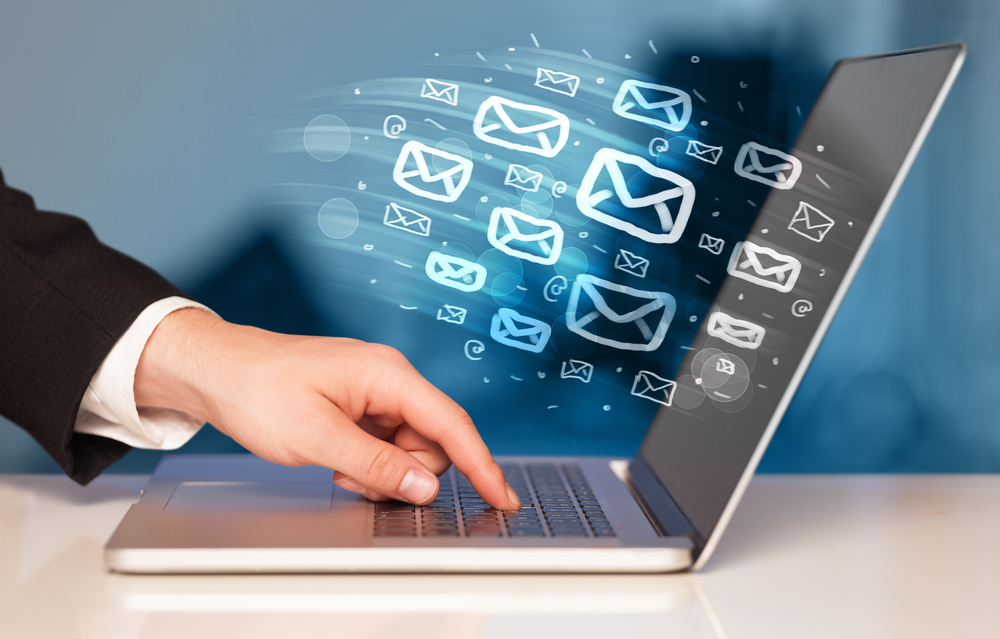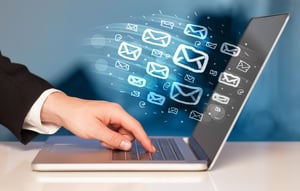Implement The Inbound Marketing Process To Revolutionize Your Business
Owning a small business is never easy. But after COVID-19, we have seen many businesses that didn't embrace digital marketing go out of business....
7 min read
 Bill Walls
:
Jan 30, 2023 11:54:12 AM
Bill Walls
:
Jan 30, 2023 11:54:12 AM

Are you looking to take your email marketing strategy to the next level?
With the right strategies in place, you can create an effective email marketing campaign that will help you achieve your goals by increasing your customer engagement, sales and ROI.
In this guide, we'll show you how to build an effective email marketing strategy, from building your list to crafting content that resonates with your audience. In 6 simple steps, we'll provide the insights and strategies you need to create a successful email marketing campaign, including:
Define Your Audience
Establish Goals
Build An Email List
Choose An Email Campaign Type
Make A Schedule
Measure Results
We all know what it’s like to get junk email. It can feel intrusive and annoying, and even if someday we have a need for a company’s services, getting bombarded by unsolicited email messages can leave us with a bad taste for that business.
unsolicited email messages can leave us with a bad taste for that business.
The most effective emails are targeted and relevant emails. To tailor your email campaign to your prospective audience’s needs, you must first begin with your buyer persona.
What is a buyer persona? A buyer persona is a fictional representation of your ideal customer that is based on real data about customer demographics and online behavior. When determining a buyer persona, take into account information that includes speculation about their personal histories, motivations and concerns.
Your buyer persona shouldn’t be a vague description of the type of person you’re gearing your marketing efforts toward. In fact, your buyer persona should define that person as specifically as possible based on well-researched demographic information.
Buyer personas should also reveal the type of information they are searching for online. Understanding your target audience in great detail helps your marketing and sales team create useful and relevant content that is valuable. This not only saves you time, resources and costs, but also increases your level of success in connecting with the people who are in need of your services or products.
Our article, Buyer Persona | What Are They And Why Do I Need Them?, helps you find your buyer personas by asking the right questions.
One of the most important aspects of building an email marketing strategy is establishing goals. A first step you can take in establishing these goals is to look at average email statistics for your industry. You can then use these stats as benchmarks.
| Industry | Open Rates | Click-Through Rates | Click-To-Open Rates | Unsubscribe Rates |
| Advertising & Marketing | 20.5% | 1.8% | 9.0% | 0.2% |
| Agriculture, Forestry, Fishing, Hunting | 27.3% | 3.4% | 12.5% | 0.3% |
| Consumer Packaged Goods | 20% | 1.9% | 11.1% | 0.1% |
| Education | 28.5% | 4.4% | 15.7% | 0.2% |
| Financial Services | 27.1% | 2.4% | 10.1% | 0.2% |
| Restaurant, Food & Beverage | 18.5% | 2.0% | 10.5% | 0.1% |
| Government & Politics | 19.4% | 2.8% | 14.3% | 0.1% |
| Healthcare Services | 23.7% | 3.0% | 13.4% | 0.3% |
| IT/Tech/Software | 22.7% | 2.0% | 9.8% | 0.2% |
| Logistics & Wholesale | 23.4% | 2.0% | 11.7% | 0.3% |
| Media, Entertainment, Publishing | 23.9% | 2.9% | 12.4% | 0.1% |
| Nonprofit | 26.6% | 2.7% | 10.2% | 0.2% |
| Other | 19.9% | 2.6% | 13.2% | 0.3% |
| Professional Services | 19.3% | 2.1% | 11.1% | 0.2% |
| Real Estate, Design, Construction | 21.7% | 3.6% | 17.2% | 0.2% |
| Retail | 17.1% | 0.7% | 5.8% | 0.1% |
| Travel, Hospitality, Leisure | 20.2% | 1.4% | 8.7% | 0.2% |
| Wellness & Fitness | 19.2% | 1.2% | 6.0% | 0.4% |
| Average Totals | 21.5% (+3.5%) | 2.3% (-0.3%) | 10.5% (-3.6%) | 0.1% (-) |
Goal setting, in general, is important in many aspects of inbound marketing (of which email marketing is an important strategy). Setting goals:
Helps focus your marketing efforts
Gives you guardrails for the type of content you want to include in the emails you send
Creates alignment between the emails you are sending and your teams (including sales, marketing and services)
Perhaps most importantly, establishing goals helps you measure the success of your efforts. Without benchmarks, you won’t be able to see how your email marketing efforts are paying off, and if there are any modifications you may need to make to your strategy.
There are many ways to build your email list. The important aspect that all these ways have in common is that the recipients have all opted in to receive your emails. This is important because these prospects have already shown interest in the type of product you are selling or the service you are providing.
Content offers are a great way to acquire emails because prospective customers must provide their emails in order to receive the piece of content. Examples of content offers include checklists, eBooks, video tutorials, white papers, how-to videos and buyers’ guides. All of these options are designed to solve a problem that the potential client needs remedied.
Content offers should always lead users back to a landing page where you can acquire their email addresses in exchange for the offer.
Other ways to acquire email addresses for your email list include:
Create a blog. A blog can be an important tool to engage prospects and customers by delivering information relevant to their needs. Not sure what to write in a blog? Blogs should have compelling content that attracts quality leads for your sales staff.
Encourage sharing. When you send emails to current email subscribers, encourage sharing or forwarding by including social media sharing buttons or an “email to a friend” option. At the bottom of the email, make sure you include a “subscribe” call to action so that anyone who receives this forwarded email can subscribe as well.
Include hyperlinked email signatures. If you have the email of a prospective client who has reached out to you with a question about services, including a hyperlinked email signature in the return can lead that person to a landing page where they can sign up to be included on your mailing list.
Use social media. Promoting an online contest or giveaway on social media can allow you to acquire contact information of those who wish to enter.
IMPORTANT NOTE: There is some debate on whether businesses should “buy” email addresses. In general, buying email lists is a bad idea. People who are on a list that is for sale don’t know you. They don’t know your product, and they likely aren’t looking for your service. Even if people with email addresses opted in to be placed on a list, they most likely opted in without knowing this list would be sold to a third party.
Let’s assume you did purchase an email list from a provider. How will your email provider view this tactic?
First, you’ll have to upload your list to your email provider. They will ask if the contacts on this list have legally opted in to receive emails from you. Since you cannot guarantee those policies were enforced when your email provider generated the purchased list, you’ll have to lie in order to get them uploaded.
Second, you send out your first email to your list. You’ll most likely find that a large percentage of those email addresses receive a hard or soft bounce. You’ll also likely see a large number of unsubscribers since they have no idea who you are and are not interested in what you have to offer.
When this happens, you run the risk of damaging your email provider's email server reputation. Platforms like Mailchimp, Constant Contact, Campaign Monitor etc., won’t allow you to continue with that sort of practice and will shut you down.
You are far better off building your email list organically through an inbound marketing strategy that allows you to build customer relationships through creating content and your social media channels.
Email campaigns vary based on the content you share and your goals. Deciding which email campaign type is best often is subjective and may change from campaign to campaign.
to campaign.
For example, your goals may be to:
Generate and direct traffic to your website where high-value content is located
Educate and boost brand awareness
Nurture leads who have already showed interest in your product or service, but haven’t made a decision yet
Offer upsell or cross-sell opportunities
Email campaigns can also come in a variety of formats, including:
Newsletters: Regularly-sent updates to subscribers on a specific topic or industry
Promotional emails: Marketing messages sent to promote a product or service
Transactional emails: Confirmation or receipts sent in response to a customer’s action, such as making a purchase
Abandoned cart emails: Sent to customers who have added items to an online shopping cart but have not completed the purchase
Win-back emails: Sent to inactive customers with the goal of re-engaging them
Welcome emails: Sent to new subscribers to introduce them to a brand or service
Survey emails: Sent to gather feedback from customers
Re-engagement emails: Sent to re-engage inactive customers and encourage them to continue doing business with a company
Referral emails: Sent to encourage customers to refer their friends and family to a company
Anniversary/birthday emails: Sent to customers on their anniversary or birthday as a way to build customer loyalty
It’s also important to set up different lists for the different types of emails you send. Customers may only sign up for certain types of emails like newsletters, or they may be in different stages of their buyers’ journeys.
Creating a schedule for your email marketing strategy is important to ensure your messages are consistent and regular. Consistency keeps your brand at the top of your audience’s minds and allows you to measure the success of your campaigns while making any necessary adjustments.
An email marketing schedule also allows you to plan and coordinate your campaigns with other marketing efforts, such as your social media marketing strategy. Coordinating your marketing tactics can amplify your message and allow you to reach a larger audience.
Drafting an email schedule can also help you avoid sending too many emails to your audience and being labeled as spam. The last thing you want is to appear intrusive. It’s always better to focus instead on sending targeted, relevant content at the right time.
| Day of the week | Open Rate | Click-Through Rate | Click-to-Open Rate | Unsubscribe Rate |
| Sunday | 20.3% | 2.1% | 10.1% | 0.1% |
| Monday | 22.0% | 2.3% | 10.6% | 0.1% |
| Tuesday | 21.8% | 2.4% | 10.8% | 0.1% |
| Wednesday | 21.8% | 2.3% | 10.7% | 0.1% |
| Thursday | 21.7% | 2.3% | 10.7% | 0.1% |
| Friday | 21.6% | 2.2% | 10.1% | 0.1% |
| Saturday | 20.5% | 2.1% | 10.1% | 0.1% |
Measuring the results of your email marketing strategy is essential to ensuring your campaign is working … AND if you need to make any adjustments to achieve better results.
Key performance indicators (KPI) are quantifiable measurements or data points used to gauge your company’s performance relative to a goal. An inbound marketing agency will help identify key performance indicators you should be tracking. This is important because different KPIs are used for different marketing strategies.
Potential agencies you are considering may also have some favorite KPIs that they like to track. However, with email marketing campaigns, some key indicators will be more important than others.
Seven important key metrics to use when evaluating the effectiveness of your email marketing campaign include:
Deliverability: Deliverability measures the rate that emails reach your intended subscribers’ inboxes.
Open rate: Open rate is the percentage of people who open an email once it arrives in their inboxes.
Clickthrough rate: CTR is the percentage of people who click on your calls to action.
Unsubscribes: This KPI measures the number of people who opt out of your email list after they receive your email.
Bounce rate: This is the percentage of emails that were not delivered due to a hard bounce or soft bounce.
Conversion rate: This rate focuses on the percentage of recipients who completed a desired action, such as filling out a form.
Overall engagement rate: This overall figure looks at any interactions with your email, from opens to clicks, replay rates and forwards.
Not all KPIs will be relevant to every email campaign, but the above indicators provide a thorough look at how an email performs so that you can make modifications to improve the outcomes you wish to achieve.
Building a successful email marketing strategy involves a number of key steps and elements, from knowing who you want to target to measure results so you can track your progress.
By putting in the effort to build a comprehensive email marketing strategy, you are better equipped to connect with your audience, increase engagement and ultimately drive revenue.

Owning a small business is never easy. But after COVID-19, we have seen many businesses that didn't embrace digital marketing go out of business....

If you are searching for ways to generate more leads for your business, it’s more than likely that you’ve come across the term “inbound marketing.”...

“A goal without a plan is only a dream.”